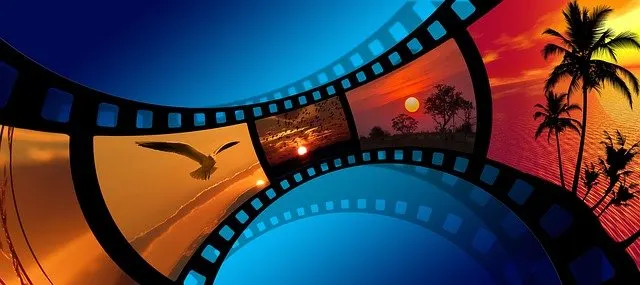
A movie theater in the backyard will not leave anyone indifferent. Especially if you’re a movie buff or if you organize soccer parties for friends. It can be a temporary setup that includes a flat screen and video player, or a special theater equipped with a modern projector and audio system. A night outdoors is a classic that everyone will love.
- Choosing the perfect location
Choosing a viewing location should be chosen wisely. It is important to consider the number of guests, various outside light sources and the capabilities of the equipment used. While a small, temporary installation with a regular TV offers a lot of flexibility, a permanent outdoor movie theater with a projector and screen requires more precise planning and enough space.
- A movie theater in the backyard of your home may require ample space
- Backyard movie theater: you can move the setup around
- Backyard movie theater with projector
- Consider some options
Not everyone is blessed with a roomy backyard with a gorgeous pergola, pool, and perhaps an incredible tiki bar. Those lucky enough to have a gazebo can use it as a spot for a nighttime outdoor movie session. People with modest or small yards, a tiny porch or patio, can use the wall of the house as a screen, and a tank of silver paint works wonders with picture quality and brightness.
- A small movie theater in the backyard
- Backyard theater on the patio
- Backyard movie theater by the pool.
- Placement and Space
Once you’ve decided on a location, it’s time to think about furniture placement and the distance between the screen (TV) and the seats. No one is really going to put out luxury armchairs and plush couches for a movie night, but a few floor cushions, fancy chairs, and maybe a couple of cozy couches will make for a most memorable evening.
If you don’t want to splurge on decor, just bring chairs and other small furniture from home to complete your viewing preparations.
- Backyard movie theater: furniture you can bring from home
- Movie theater on the roof
- Backyard movie theater: stationary couches
- Choosing the right equipment
Budget plays a big role here. Obviously, a high-quality outdoor projector combined with a serious sound system will cost significantly more than a more modest flat-screen option. Modern outdoor TVs may not have all the features of their home counterparts, but they are definitely much safer.
Also, make sure you connect all the wires properly, and turn on an Internet-enabled video player so you can watch all the latest news.
A video wall, or LedWall
A video wall, or LedWall, is an LED screen composed of a variable number of modules that can be CRT monitors, rear-projected panels, liquid crystal or plasma screens. The elements can be combined with each other to achieve the desired size of the LED screen. Each element, properly driven by a special control unit, displays only part of the complete image, which is displayed entirely by all the screens that make up the video wall, which behave like the tiles of a mosaic.
In addition to classic installations (screens are positioned horizontally and placed side by side to form a big screen whose size ratio is 4:3 or 16:9), video walls with different shape ratios or with positioning of the elements even in three dimensions (e.g., “circular” video walls) are possible.
The major problem with this type of screen was initially due to the presence of the unsightly frames that surround the elements that compose it, generating an annoying “checkerboard” effect; later, as technology evolved, video walls appeared on the market that minimized if not eliminated the problem, using frames of very small thickness (a few millimeters) that are invisible at a distance.
The main disadvantages of video walls made of LCD panels
- Shorter life of the LCD panels of video walls (up to 50% decrease in panel brightness over time)
- Sometimes the initial brightness is not enough (~500 cd/m2)
- Framed seams between the LCD panels distract viewers
LED LED screens are constructed from fairly small individual modules, but the final size of the video wall can be quite large. LED-modules come in both indoor and outdoor versions, which explains the great popularity of this technology in the field of advertising.
The main advantages of LED screens
- Excellent brightness and color rendering (800-1200 cd/m2).
- Long service life. Given the high initial brightness after 5 years, even after a slight burnout of LEDs is big enough margin of brightness
- The presence of options for outdoor use
- Sufficient viewing angles
- No seams between the cabinets for any screen size
To rent LED go to rentforevent.com
- Protection from bad weather
A shaded porch, patio, or poolside spot with a pergola will provide weather protection for your outdoor TV in most cases. But for those who use the TV from the living room to watch movies at night, a glass enclosure for bad-weather protection is a must. This solution will perfectly protect your precious big-screen TV, and you’ll avoid any unforeseen incidents. (It’s a good idea to check the weather forecast for the evening).
- A movie theater in the backyard of a house with shutters
- Backyard movie theater: shutters will save your equipment from the weather
- A backyard movie theater with a roof.
- Lighting and furnishings.
As for mood, go for soft lighting options. Candles, low-intensity LED floor lighting, streetlights, or even lanterns are perfect for this. The goal should be to create a certain level of brightness so everyone can see where they are going, but no more.
- Backyard movie theater: lighting
- A movie theater in the backyard of the house in a gazebo
- Don’t forget the neighbors
Don’t forget to warn your neighbors about the upcoming outdoor event. Make sure that the nighttime movie viewing doesn’t become a loud inconvenience to others. Also, stock up on food and drinks to fully immerse yourself in an unforgettable evening.
- Sagittarius Man & Gemini Woman Love and Sex Compatibility - January 31, 2024
- Taurus Ascendant Rising Personality Traits in Men (Guide) - January 31, 2024
- How to Seduce and Attract a Sagittarius Man (Seduction Tips) - January 31, 2024
